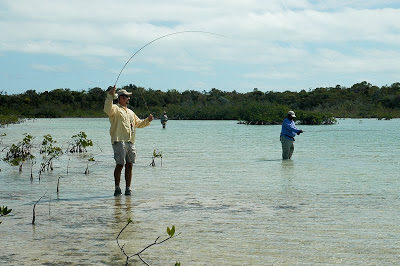
In the past we’ve covered how to spot bonefish, and how to set the hook on a bonefish. Great, you’ve done it all right and you’ve got one hooked up. Now what?
Here’s what.
- Let him run. As soon as you’re confident that you’ve got the hook set (you strip-set, right?), let that fish run. Bonefish can initiate runs really suddenly, so at all times that you’ve got one hooked up, you need to be ready to let go of that reel handle in a split-second in case that fish turns to go. Any time during a fight that you feel the start of a deep tug, let him run.
- Put the heat on. As soon as that fish stops or turns direction, put the heat on! If you’re fishing on South Andros Island, you’re probably using a tippet that’s stronger than 12 pounds, so you can and should pull really hard. Don’t raise your rod like you’re fighting a trout with a 4 weight – pull back on the butt of the rod, with the rod at a relatively low angle to the water. Fighting the fish hard will get him landed more quickly, minimizing the time that the fish can get exhausted and/or chowed by a predator like a shark.
- Keep the line at an acute angle. This isn’t geometry class, so we’ll do our best to keep the explanation simple. The most force is exerted on a fish when you’re pulling on them at a severe angle relative to the direction that they’re swimming. Here’s the easiest way to put this into practice – if the fish is swimming left to right, you should be pulling hard to the left. Don’t drag him along like a dog on a leash – pull hard in the other direction as this gets him landed quicker.
- On a smooth bottom, keep the rod tip low and to the side. You can exert the most power on a fish with your rod low and to the side – this enables you to bend the butt of the rod, which is much more powerful than the tip. Get down and dirty, and switch sides as necessary according to tip #3.
- On a bottom with mounds, coral or weeds, keep the rod tip high. No matter what you don’t want your fish, fly, and leader being dragged through muck, sand, weeds, or coral – that’s not a recipe for staying connected to your fish. Although we told you to keep the rod tip low in #4, here we’re saying that you should keep your rod tip high when your fish is swimming through the junk. This will keep his nose a little higher and prevent him from being pulled sideways into an obstruction. You can still bend the butt of your rod when its tip is high – you just need to work at it a little more.
We’ll be putting these fun tips into practice at Andros South starting on October 10th!
Leave a Reply